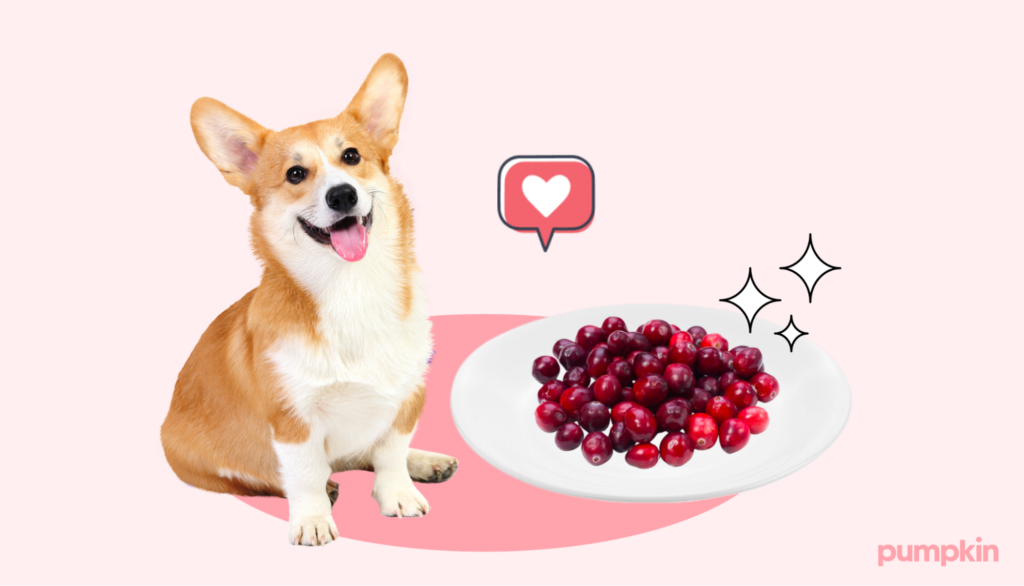Key Points:
- Dogs can eat cranberries in moderation.
- Fresh cranberries offer dogs vitamins C, E, and K, along with fiber.
- Dogs should avoid most cranberry sauces and juices due to the added sugars.
Around the holidays, pet parents want to include their pup in the festive feast by sharing holiday meal staples such as turkey and cranberries. And, like turkey, dogs can eat cranberries. But it’s important to know how to safely share this tart little fruit.
Lean turkey is very beneficial for dogs, but roast turkey prepared with onion and garlic can be downright toxic. In the same way, fresh cranberries are nutritious, but your favorite cranberry sauce? Not so much.
So, read on to learn how cranberries can help your dog’s diet — and some risks to know.
Are cranberries safe for dogs?
Cranberries are a superfood for humans because of their high antioxidant and nutrient content. For dogs, fresh cranberries are a safe and tasty low-calorie treat.
Cranberries are composed of 87% water and 12% carbohydrates, with a half cup of cranberries containing only 25 calories. This makes them a hydrating snack for dogs, especially those that are overweight or diabetic. The fiber in cranberries also helps dogs feel full for longer and moves food and waste through the digestive system more efficiently.
Pet Pro Tip: If you have a dog that is prone to ‘snacksidents’ – you should consider getting a dog insurance plan as soon as possible. It can help you afford the best care in the future by covering eligible vet bills for digestive illnesses, toxic ingestion, and more.
Even though cranberries are low in calories, they’re acidic so moderation is key. Remember that treats for dogs, including human foods and holiday table scraps, should only make up 10% of their daily calories.
Health benefits of cranberries for dogs
Raw cranberries contain many vitamins and minerals that protect your pup’s heart, regulate their metabolism, and build healthy blood cells, such as:
- Vitamin C
- Vitamin E
- Vitamin B1 & B2
- Vitamin K
- Potassium
- Manganese
- Iron
Cranberries are also known for their antioxidants. Antioxidants promote immune health, fight inflammation, and prevent cell damage. Antioxidants also improve cognitive function, possibly helping prevent cognitive decline in older dogs.
Cranberry extract, cranberry supplements, or just adding cranberries to your dog’s diet may help dogs who suffer from chronic or frequent urinary tract infections. Of course, always speak to your veterinarian before adding new supplements to your dog’s diet.
Even with the nutritional value, pups must stick to small portions, so the potential health benefits of cranberries for dogs will be minimal.
Risks of feeding cranberries to dogs
When it comes to cranberries, there are some small risks that come with offering it as a treat:
- Cranberries are very acidic, and too many can cause an upset stomach, vomiting, or diarrhea.
- Cranberries contain oxalates, which could result in bladder stones over time.
- Watch out for trail mixes with cranberries, as they may also contain dangerous nuts, raisins, and chocolate.
When accidents or illnesses do happen, pet parents should be focused on getting the best possible care, not how they’ll pay for expensive vet bills. Having a pet insurance plan in place in case of future accidents can help you get your pup the best care without putting too big of a dent in your wallet.
How to serve cranberries to dogs
Feeding your pup fresh cranberries is the best option if they’re begging for a taste.

However, many dogs don’t care for the bitter taste of this tart treat and may prefer a blueberry or strawberry instead.
While cranberries are safe, most cranberry products are not. Cranberry foods require a little more investigating to determine if they’re safe for your pooch to eat:
- Dried cranberries are safe for dogs as long as they have no added sugars.
- Plain cranberry sauce from a can almost always has sugar or another sweetener that’s unsafe for dogs.
- Frozen cranberries are safe as long as they’re thawed first to avoid a choking hazard
So, are cranberries safe for dogs?
The next time you prepare your Thanksgiving meal, remember to save a few plain cranberries for your tail-wagging friend. Fresh, plain cranberries are safe for dogs, and they’re good for them, too.
FAQs
- https://www.ncbi.nlm.nih.gov/pmc/articles/PMC8911768/
- https://www.akc.org/expert-advice/nutrition/how-many-treats-can-dog-have/
- https://fdc.nal.usda.gov/fdc-app.html#/food-details/171722/nutrients
- https://health.clevelandclinic.org/benefits-of-cranberries
- https://vcahospitals.com/know-your-pet/nutrition-for-dogs-with-cognitive-dysfunction-syndrome-cds
- https://www.preventivevet.com/pets/cranberry-and-your-pets-urinary-health
- https://vcahospitals.com/know-your-pet/calcium-oxalate-bladder-stones-in-dogs




